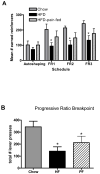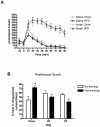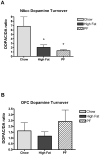Exposure to elevated levels of dietary fat attenuates psychostimulant reward and mesolimbic dopamine turnover in the rat
- PMID: 19045945
- PMCID: PMC2597276
- DOI: 10.1037/a0013111
Exposure to elevated levels of dietary fat attenuates psychostimulant reward and mesolimbic dopamine turnover in the rat
Abstract
Recent studies indicate that decreased central dopamine is associated with diet-induced obesity in humans and in animal models. In the current study, the authors assessed the hypothesis that diet-induced obesity reduces mesolimbic dopamine function. Specifically, the authors compared dopamine turnover in this region between rats fed a high-fat diet and those consuming a standard low-fat diet. The authors also assessed behavioral consequences of diet-induced obesity by testing the response of these animals in a conditioned place paradigm using amphetamine as a reinforcer and in an operant conditioning paradigm using sucrose reinforcement. Results demonstrate that animals consuming a high-fat diet, independent of the development of obesity, exhibit decreased dopamine turnover in the mesolimbic system, reduced preference for an amphetamine cue, and attenuated operant responding for sucrose. The authors also observed that diet-induced obesity with a high-fat diet attenuated mesolimbic dopamine turnover in the nucleus accumbens. These data are consistent with recent hypotheses that the hormonal signals derived from adipose tissue regulate the activity of central nervous system structures involved in reward and motivation, which may have implications for the treatment of obesity and/or addiction.
Figures




References
-
- Balfour ME, Yu L, Coolen LM. Sex behavior and sex associated environmental cues activate the mesolimbic system in male rats. Neuropsychopharmacology. 2004;4:718–30. - PubMed
-
- Berthoud HR. Mind versus metabolism in the control of food intake and energy balance. Physiology and Behav. 2004;81:781–793. - PubMed
-
- Berridge KC, Robinson TE. Parsing reward. Trends in Neurosci. 2003;26:507–13. - PubMed
-
- Bassareo V, Di Chiara G. Modulation of feeding-induced activation of mesolimbic dopamine transmission by appetitive stimuli and its relation to motivational state. Eur J Neurosci. 1999;11:4389–97. - PubMed
-
- Bina KG, Cincotta AH. Dopaminergic agonists normalize elevated hypothalamic neuropeptide Y and corticotropin-releasing hormone, body weight gain, and hyperglycemia in ob/ob mice. Neuroendocrinology. 2000;71:68–78. - PubMed

